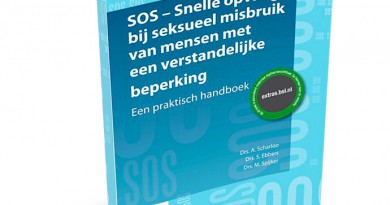Nora Baladerian & Aafke Scharloo : Training Risk Reduction bij seksueel misbruik van mensen met een verstandelijke beperking
Dr. Nora Baladerian uit de VS heeft een Risk Reduction Workbook for Parents and Service providers geschreven. Dit boek is een handleiding om te komen tot een IAP (Individueel Actie Plan) en gaat uit van de redenatie dat omdat mensen met een beperking een veel grotere kans hebben misbruikt te worden dan anderen het goed is om voorbereid te zijn. Een individueel plan van aanpak mèt brandoefening zou je kunnen zeggen. Uit ervaring blijkt dat diegene die goed voorbereid zijn ( Client en ouders en/of en zorgaanbieder) een betere prognose hebben om het misbruik te kunnen verwerken dan diegene die dat niet hebben. Dat komt omdat slachtoffers als zij goed zijn voorbereid, minder last hebben van de typische met seksueel misbruik gepaard gaande symptomen als schaamte, neiging tot geheimhouding, hopeloosheid en hulpeloosheid.
De dag wordt verzorgd door Nora Baladerian en Aafke Scharloo samen.
Aafke is bezig het werkboek te vertalen en toepasbaar te maken voor de Nederlands situatie.
Na een inleiding in de ochtend door Nora over het ontstaan en de achtergronden van het werkboek wordt vooral praktisch gewerkt met het maken van een Individueel Actie Plan met eigen rollen voor de client zelf, de ouders en zorgaanbieders.
Doelgroep voor deze dag is breed: orthopedagogen /psychologen, MEE medewerkers, vaktherapeuten, begeleiders/ thuisondersteuners, gezinsvoogden en ouders/ mensen van de oudervereniging.
Voertaal is Engels. Bij de start van de dag ontvangt iedereen een map met de Engelse uitgave van het Risk Reduction Workbook aangevuld met Nederlands materialen die in het middag programma gebruikt worden.
Tijd,plaats & kosten:
De training vindt plaats op 6 oktober bij Milu in het centrum van Den Haag (Driehoekjes 15)
Aanvang 9.30 tot 16.30
De kosten bedragen 250 euro per persoon.
Globaal Programma:
- 9.00: Registration
- 9.30: Opening & Introduction
- 9.45: Introduction to Risk Reduction by Nora Baladarian
- 11.00 Coffee break
- 11.15 Elements of an individualized plan:
Dividing the plan in 3 time frames: before, during and after an assault
- 12.30 Lunch
- 13.30 Participant in the plan: The person with the disability, the parents/family and the service provider. Who does what & How to work together
- 14.15 Risk Reduction in the Netherlands. Discussion: Thoughts and feelings of the participants.
- 14.45 Break
- 15.00 Small group work: Practising; Making an IAP ( Individueel Actie Plan)
- 16.00 Reflection, tips & trics, Q&A
- 16.30 End
meer info:
Risk Reduction Workbook by Nora Baladarian.
In light of the fact that individuals with disabilities are more likely to experience crime victimization than their peers who do not have disabilities, and that statistically, those who have experienced crimes are more likely to be victims of crime again, it is prudent to discuss this frankly with individuals with developmental disabilities and their families, and to make a plan.
In my professional experience, those who have worked together as a family and designed such plans have had a much better outcome following succeeding crime victimizations than those who did not make a plan. In other words, the victim feels much less traumatized because many of the typical symptoms including shame, helplessness, and feeling dirty are absent from post-rape experience. Instead, the individual feels good that they had a plan and executed the plan under such critical circumstances, good that their planning partner (parent, sibling, etc.) also did their part of the plan, and a sense of empowerment seems to overshadow all other post-trauma events.
The perpetrator has a plan, but potential victims tend to walk around without a plan, and get caught off guard. They do not focus on making plans for emergencies. Yet, when crime happens, the attacker has a plan…so should potential victims, which means all of us. It just makes sense.
The book describes the elements of an individualized plan. It is divided into the only three possible time frames that exist for potential victims: before, during, and after.
When you implement this plan, the victim feels empowered by having done all that is possible to do in this situation. Many victims find that what would normally be traumatic and result in feelings of shame, helplessness, and other negative feelings are instead feelings of empowerment, pride in self, and less trauma. They understand that the criminal has done terrible things, but the victim and partner had a plan also, did their plan, and have had the best possible outcome. “My power is AFTER” is the motto for DURING, and “Knowledge is Power” is the motto for AFTER. The key for BEFORE is the understanding that the criminal or perpetrator has a plan, so should you.



